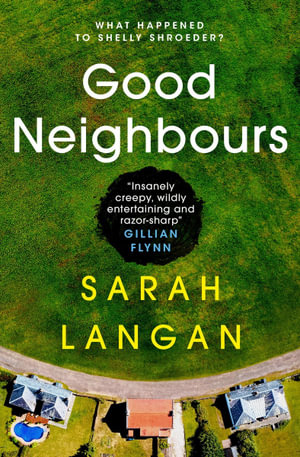Good Neighbours by Sarah Langan

A disturbing and ruthless portrayal of the darkness of suburbia, Good Neighbours chronicles the events leading up to the fictitious 2027 Maple Street Murders. The plot is foreshadowed through the inclusion of fictitious media and scholarly reports teasing the tragedies soon to befall the characters.
Good Neighbours is set in Maple Street, a picture-perfect slice of suburban Long Island. This illusion is shattered when, devastated by an unforgiving heatwave, suburban Queen Bee Rhea organises a neighbourhood fourth of July barbecue to lift morale. All of the families in the neighbourhood are invited, except for the Wilde family. When they decide to show up anyway, assuming that their exclusion was an accidental oversight, tensions mount. Then, the earth opens up – an enormous sinkhole emerges in the park bordering the neighbourhood crescent. 6 days later, Rhea’s daughter Shelly falls inside, frantically running with Julia Wilde towards a better future after finally unloading a dark secret. Good Neighbours follows the Orwellian, futuristic neighbourhood as poisonous accusations are thrown around, testing loyalties, and putting the Wilde family in danger, until the climactic end of the novel in which blood is finally spilled.
Told through multiple perspectives that encourage the reader to treat the entire Maple Street neighbourhood as complicit in the tragedies that befall them, Good Neighbours is a thrilling dystopian story, exploring the notions of community, conspiracy, secrets, and betrayal. Langan asks the reader to consider whether history can ever really be truthful, and reminds us the importance of critically analysing information presented by seemingly trustful sources; fitting in the era of “fake news” and a world in which it is increasingly difficult to trust your instincts and far easier to follow the trend of those around you.
This novel is a stunning example of the importance of literature in asking hard questions through the lens of fictional narratives, and of understanding the things that make us human. As Gertie reflects towards the end of the novel, we must never fear showing others our “mess”. That is the true meaning of togetherness.
Recommended for students 17+ due to the distressing descriptions of death, abuse, betrayal, and violence within the novel. Also features descriptions of distressing acts of violence, including gun use, and includes brief sexual references.
Themes: Suburbia, Family, Community, Mental health, Abuse, Mystery.
Daniella Chiarolli